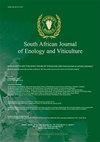软木闭瓶发酵起泡酒中的酚类化合物
IF 1.1
4区 农林科学
Q4 FOOD SCIENCE & TECHNOLOGY
引用次数: 2
摘要
南非的瓶装发酵起泡酒被称为Methode Cap Classique,它是基于法国用于香槟的方法。研究了在起泡酒二次发酵过程中使用软木塞代替冠盖对葡萄酒酚类物质的影响。在来自三个不同商业供应商的两个圆盘软木塞中研究了易从软木塞迁移到葡萄酒中的酚酸类物质,这些软木塞编码为cork A、cork R和cork C,并配有冠盖。使用液相色谱技术对所有样品中的没食子酸、咖啡酸、咖啡酸类和对香豆酸类进行定量。用分光光度法测定了葡萄酒的理化参数。不同葡萄酒的总酸度和pH值没有显著差异。然而,软木R葡萄酒的酒精含量却有很大的不同。所有样品的残留糖均低于检测限。没食子酸在科克A葡萄酒中含量显著最高,这表明科克A对葡萄酒中该化合物浓度的贡献。假设不同类型的软木会释放不同浓度的酚类化合物。这可能是由于软木表面粗糙度的差异,这会增加与葡萄酒接触的表面面积。因此,来自不同产地(供应商)的软木塞可以用来为葡萄酒带来细微的差异。本文章由计算机程序翻译,如有差异,请以英文原文为准。
Phenolic Compounds in Cork-Closed Bottle-Fermented Sparkling Wines
Bottle fermented sparkling wine in South Africa is known as Methode Cap Classique which is based onthe method used in France for Champagne. The use of cork, instead of a crown cap during the secondfermentation in sparkling wine was investigated for its effect on the phenolic profile of wines. Phenolicacids susceptible to migration from cork into wine were studied in two-disc corks from three differentcommercial suppliers, coded as Cork A, Cork R and Cork C and a crown cap closure. Gallic, caftaric,caffeic and p-coumaric acids were quantified in all samples using a liquid chromatographic technique.Physicochemical parameters were also measured in the wine using a spectrophotometric technique. Totalacidity and pH were not significantly different among the wines. Cork R wines were however significantlydifferent in alcohol. Residual sugar for all samples was below the limit of detection. Gallic acid wassignificantly highest in Cork A wines, which indicates the contribution of Cork A to the concentration ofthis compound in the wine. Different cork types are assumed to release different concentrations of phenoliccompounds. This may be due to differences in surface roughness of cork that would increase the surfacearea in contact with the wine. Therefore, corks from different origins (suppliers) could be used to bringabout subtle differences to the wine.
求助全文
通过发布文献求助,成功后即可免费获取论文全文。
去求助
来源期刊
CiteScore
2.50
自引率
7.70%
发文量
1
审稿时长
>36 weeks
期刊介绍:
The South African Journal of Enology and Viticulture (SAJEV) publishes full-length original Research Papers, Research Notes and Review Papers on all subjects related to enology and viticulture. The SAJEV does not accept articles published in, or submitted to, other journals.

 求助内容:
求助内容: 应助结果提醒方式:
应助结果提醒方式:


